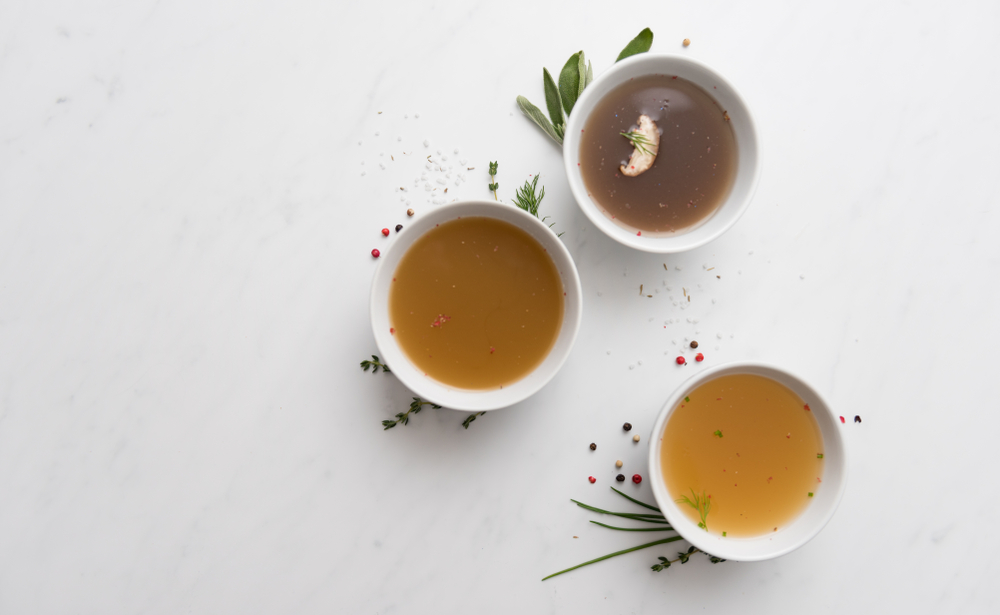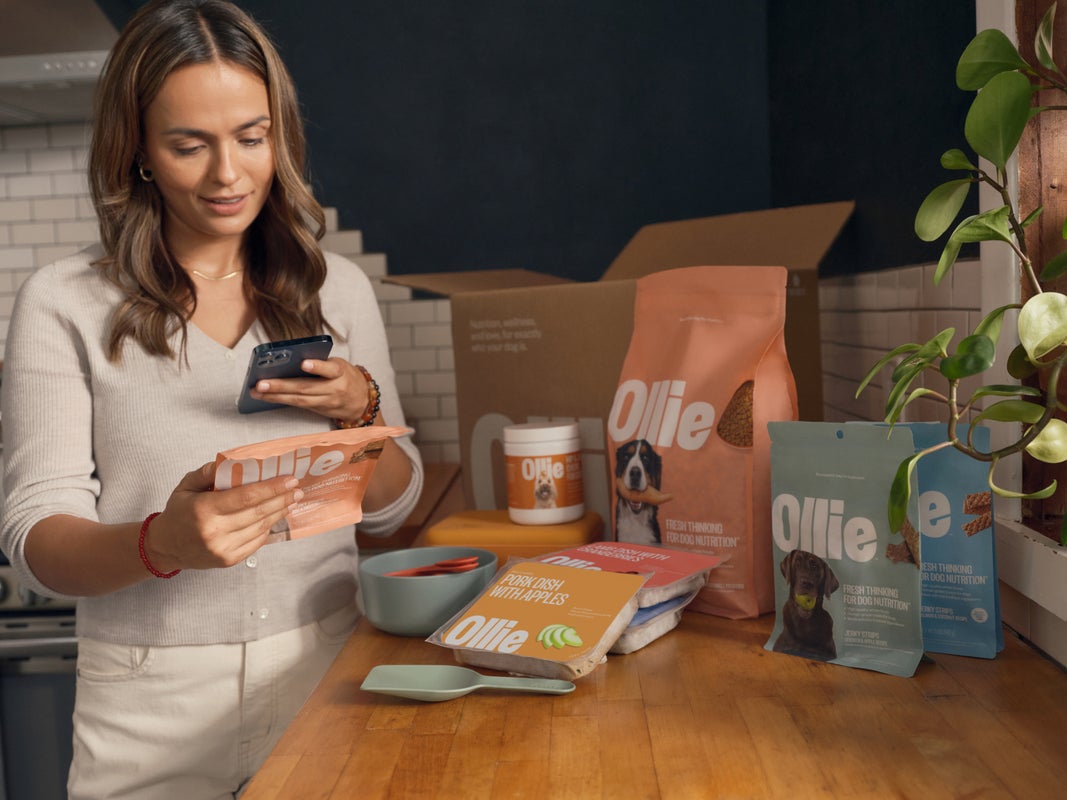Hey Ollie blog readers! We’re offering you an exclusive 60% OFF your starter box! Try now!
When you’re under the weather, nothing is more comforting than a warm bowl of chicken soup. In addition to being delicious, research has shown that chicken soup has healing properties and many health benefits. The vitamins, minerals, and collagen in animal bones are great for our immune systems and even gut health.
What you may not know is that chicken soup, and other bone-based broths are also great to feed your dog. With a few modifications, you can create delicious broths that both you and your pet can enjoy. Broth can help a picky eater enjoy food, a sick dog feel better faster and even help with other issues that pop up as dogs age.
What is bone broth?
Bone broth is a liquid containing brewed bones and connective tissues. Sounds kind of gross, but stick with us!
To make bone broth, people use cow, chicken, and even fish bones. Simmering the bones in water with some vinegar (like apple cider vinegar) helps release nutrients from the marrow within the bones, as well as break down other tissues into the water.
You may be wondering how bone broth is different from beef or chicken stock? It’s not so different except for the fact that bone broth usually simmers much longer than traditional stock. Some people let the bones simmer for as long as 16 -24 hours to get the most collagen and nutrients from the bones.
Vegetables and herbs are often added to the broth to boost the flavor. Some people (and dogs) may have a strong preference for certain kinds of broth and certain flavors. You’ll generally find that people who make broth often have a go-to recipe.
7 simple steps to dog-friendly bone broth
Don’t let long cooking times intimidate you. Bone broth can be both easy and inexpensive to make. You can make large batches and freeze smaller portions for your dog so you don’t have to make it as frequently and you have some on hand if you need it.
My favorite bone broth recipe is one I’ve adapted so both my dog and I can enjoy it. Before creating this recipe, I used to have to make two pots at a time so we’d both have our own broth to enjoy.
My recipe omits onions and garlic to ensure the safety of the broth for my dog. While onions are a no go, there is some evidence that garlic, if used correctly can be beneficial. I still personally opt not to add garlic to broth or soup I am preparing for my dog.
1. Gather your ingredients and equipment
- 1 whole chicken (5-8 pounds)
- 3-4 medium-sized carrots, peeled or just cleaned well
- 3 stalks of celery, cleaned
- 1 big handful (about half a bunch) flat-leaved parsley
- 1 big handful (about half a bunch)
- salt to taste ( I use ½ to ¾ tablespoon of pink Himalayan salt)
- 10-12 cups of water
- 8-12 quart stockpot or slow cooker with similar capacity
- a fine mesh strainer
- a second pot or bowl to strain the finished broth into
2. Place ingredients in the slow cooker or stockpot
Add the chicken, veggies, herbs, and salt and then use the water to cover them. Be careful not to overfill your pot or slow cooker – take note of any max fill lines if you’re using a slow cooker.
3. Simmer for 12 – 24 hours
This is the hard part, waiting and waiting for the bone broth to be done. I like using the slow cooker and letting the broth cook itself overnight. Make sure you are home when you have a stockpot on the stove and a working smoke detector. For either method ensure your dog can’t get to the pot or slow cooker – safety first! Your house will smell nice while the bone broth is cooking. If I simmer my broth during the day my dog now knows what is happening and he will go sniff near the pot to ask for some.
4. Strain out the liquid
When you’re done simmering, you’ll want to grab your second pot or a large bowl. Get your fine mesh strainer and pour the hot liquid through it into the clean pot or bowl. Be careful as you do not want to get burned or spill hot bone broth. In the original pot, you’ll have your chicken meat, bones, and all the veggies. I pull out the chicken meat and carrots to use at the end when I am making chicken soup. I discard the celery and herbs along with the chicken bones at this point. The celery and herbs tend to be mushy by this point and completely unappealing.
5. Allow the bone broth to cool down
As the broth cools, the fat will all rise to the surface. This fat is not great for your dog so you will be able to remove it easily in the next step. You may want to reserve some of this fat for other uses in the kitchen. If not, you can simply discard it along with the chicken bones, herbs, and celery.
6. Skim off the fat
You should now see a yellow or white layer of solid fat at the top of your bone broth. It should be very easy to grab a spoon and scrape this off. Underneath it, you should see your bone broth has a jello-like consistency. The firmer and more jiggly the consistency, the more collagen your broth contains! Don’t worry if it is not jiggly – there is nothing wrong with it – you may just need to simmer longer next time or add more bones. Chicken necks and backs have the most collagen. You can ask a butcher for extra of these parts next time you want to make the broth. As a note, the meat does not add any flavor to the bone broth here – you can just use bones from rotisserie or roasted chicken or ask your butcher for bones. In this recipe, we will use the chicken meat in the next step, to make a dog-friendly chicken soup.
7. Use your bone broth to make other soups for you and your dog
This step is completely optional! Your dog can just lap up the broth or you can put it on his food to soften it and make it more appealing. If you’re considering becoming an Ollie customer or are just introducing your pet to eating fresh food, we recommend adding some broth to the food for the first few times.
One of my favorite things to have in my freezer is what I call a “Pup Cup”. To make them, I chop up the cooked chicken breast (just white meat) and the carrots as well as some fresh parsley. I add back some of my bone broth to this mixture so it looks like a bowl of chicken soup without the noodles. I then take 4-ounce food storage containers and fill them with these soups and keep in the freezer for any time I think my dog needs a boost.
Now when it comes to using this bone broth to make soups for humans, remember that we did not add any extra salt after cooking – you might need a little more salt here to make it pleasing to your palate (you also might not). This broth makes a great base for all kinds of soup for humans and can be used in any recipe that calls for chicken broth or stock.
4 different recipes for bone broth
While the recipe shared above is my personal favorite and gets rave reviews from my pup, it is far from the only way to make a healthy and nourishing broth. Some dogs are allergic to chicken and should also not enjoy broth with chicken meat or bones. Here are some great alternative recipes and nourishing additions:
1. Beef Bone Broth
Here is a super simple recipe for beef bone broth from Darwin’s Natural Pet Products. Its easy to make and they provide some great ideas for veggies and herbs to add to boost the flavor. Try a few combinations and see which ones work best for both you and your dog!
2. Mushroom Bone Broth
You might be thinking, “Aren’t mushrooms toxic to dogs?” and the answer is only some of them are. Other mushrooms are a great addition to your dog’s diet. This recipe contains both bones and mushrooms for the ultimate health boost.
3. Fiskessuppe
This is just a very fancy way to say a bone broth with a fish bones as the base. To do this, you can follow my original recipe above but omit the dill and swap out the whole chicken for 4-5 pounds of fish bones including the heads, tails, and trimmings from cleaning. You might want to make a smaller batch at first, and Dr. Suzi Berber walks through all of the directions in her post for Animal Wellness Magazine.
4. Broth Boosters
If you need to give your pet an additional ‘boost’ of nutrition you can add all kinds of things to your bone broth to make it both more nutrition and more delicious! I like to put roasted butternut squash or pumpkin in my blender with a few ladles of broth. Just a note – you can make the consistency as thick or thin as you like but both squash and pumpkin are high in fiber so don’t overfeed your dog. You also should not feed your dog store-bought butternut squash soups (or even some homemade family recipes) as most contain both onion and nutmeg which are toxic to dogs.
Benefits of Bone Broth
Tasting great isn’t the only reason to share a delicious bone broth with your dog, here are 5 benefits of giving broth to your pup.
- Helps maintain a healthy gut, especially for dogs with digestive issues.
- Supports your dog’s immune system including detoxing the liver.
- Protects joints with minerals including calcium, silicon, magnesium and phosphorous.
- Provides nutrition for dogs who are ill, can’t chew properly or are recovering from injuries or surgery.
The Ollie blog is devoted to helping pet parents lead healthier lives with their pups. If you want to learn more about our fresh, human-grade food, check out MyOllie.com.
Tagged As:

The nutrition your dog needs,
the food they want.

Enjoying our articles? Subscribe our Newsletters and get new articles directly to your inbox
You might also like
26 August 2025
4 MINS READ
Is Fresh Dog Food Safe?
If you’re thinking about switching your dog to a fresh food diet, you might be asking yourself: “Is fresh dog food safe?” It’s a smart question—because feeding fresh means you’re worki…
by Ollie Pets
26 August 2025
4 MINS READ
How Do I Know How Much Fresh Dog Food To Feed?
If you’ve switched your pup to fresh food, you’re probably wondering: “How much fresh dog food should I feed?” It’s not as simple as scooping kibble from a bag—fresh food is more nutri…
by Ollie Pets
26 August 2025
4 MINS READ
Do I Need To Cook Fresh Dog Food?
If you’ve just started exploring fresh dog food, you might be wondering: “Do I need to cook it?” or “Is it raw or already cooked?” It’s a common question, especially with so many pet f…
by Ollie Pets







